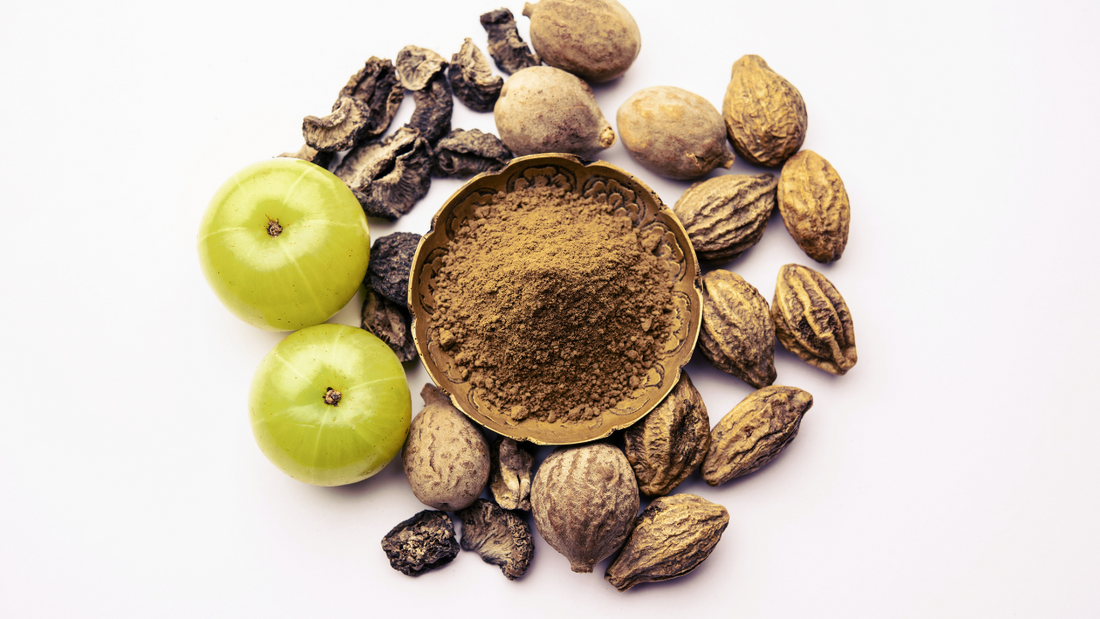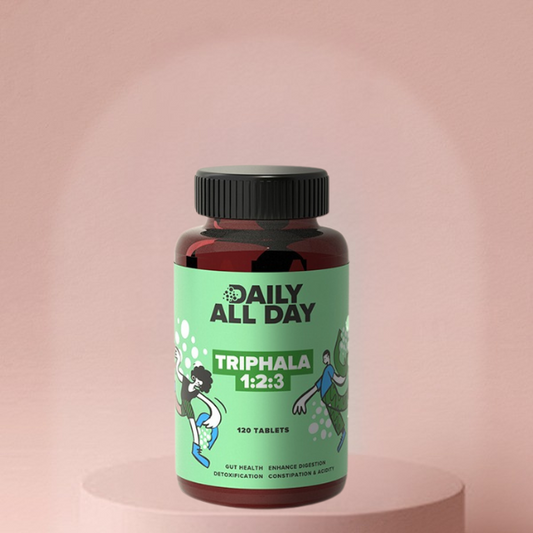Triphala 1:2:3: The Wisdom of Vagbhata
Share

Triphala is a multi-purpose medicine which has been used in Ayurveda since ancient times. It promotes longevity. Triphala is a combination of three fruits emphasized by ancient Ayurvedic writer Vagbhata in his work Ashtanga Hridayam. He has elaborated the significance of Triphala with 1:2:3 ratio. Let’s delve into the concept and importance of Triphala to educate ourselves about the wondrous benefits of Triphala.
What is Triphala?
Triphala in Ayurvedic medicine, is a herbal preparation which comprises three dried different fruits. Triphala in Samskrit means three fruits i.e. Amla, Haritaki (Harad),and Bibhitaki (Baheda). Instead of the fruits taken separately, Triphala is taken as it is more effective and provides healthier benefits.
Ayurveda encourages multiple herb mixes like Triphala to treat a variety of different health issues and prevent chronic diseases.
What are The Components of Triphala?
Triphala consists three fruits with important nutrients:
- Amla (Phyllanthus emblica)- Amla fruits are acrid and astringent. The raw fruits are useful in relieving constipation, while dried fruits are helpful in jaundice and haemorrhage. The fruit is an excellent source of vitamin C (70-72%) that is more easily blended in the human body than the synthetic vitamin C.
It enhances food absorption, balances stomach acid, strengthens vision, promotes healthier bones, supports heart and blood circulation, etc. The plant is a powerful Rasayana (rejuvenator) drug in Ayurveda that balances both ‘pitta’ and ‘vata’, and has a unique natural balance of five tastes- sweet, sour, pungent, bitter and astringent in the fruit.
- Haritaki (Harada) (Terminalia chebula)- It is well-known in the Ayurveda system for its antibacterial, anti-viral and antioxidant properties. Harada is widely used in rejuvenation therapies as it is rich in iron, vitamin C, potassium, copper and manganese. It helps reduce acne, combat aging and improve skin and hydration. It is known for its healing properties.
- Bibhitaki (Baheda) (Terminalia bellirica)- In Ayurveda, the drug is classified as an expectorant, a substance that helps you cough up mucus from your lungs. The fruits are astringent and rejuvenating. It is a very commonly used fruit both in Unani and Ayurveda, as antioxidant and to strengthen digestive function, and in cases of chronic diarrhea and dysentery. It forms an integral part of Ayurvedic formulation, Triphala.

Why Triphala With 1:2:3 Ratio?
One of the herbal drugs like Triphala has a lot of significance in our life as it cures many diseases. In the Ayurvedic literature Triphala is extensively described. It is used internally and externally in various diseases. In the Ayurvedic literature it is one of the most important commonly used herbs. Presently it is considered as an important anti-diabetic and antioxidant drug.
The common and typical formula of Triphala is 1:1:1 ratio of its three components; Amla, Bibhitaki and Haritaki. This equal and balanced ratio provides synergistic benefits as these components work together to elevate health.
The formula of 1:2:3 ratio of Triphala is given by ancient Ayurvedic writer Vagbhata in his work Ashtanga Hridayam. The ratio refers to the specific proportions of all the three components; Bibhitaki (1 part), Haritaki (2 parts), and Amla (3 parts) and this formation highlights the unique qualities and properties of each fruit. In his book which is one of the three treatises of Ayurveda as well, Vagbhata describes this certain ratio to optimize the synergistic effects of the components. The emphasis on the different ratios aims to increase the therapeutic benefits of Triphala, making it a more balanced formula that goes well with various health issues.
Effectiveness of Different Proportions
As Amla is a powerful Rasayana in Ayurveda, it focuses on rejuvenation and antioxidant effects which are particularly beneficial for overall health. It is believed to provide the formulation with rejuvenative and detoxifying effects.
While Amla supports rejuvenation,longevity and regeneration, Bibhitaki aids in the treatment of common cold and constipation, and Haritaki enhances cognitive function, supports respiratory health, and helps maintain gut balance.
Therapeutic Benefits of Triphala
Triphala is perhaps most well-known for its use in general health. It is classified as a Tridoshic Rasayana; that the energetics are appropriate for Vata, Pitta and Kapha and all types of patients.
- Digestive Health- Triphala is known for its ability to support digestion and mitigate constipation. This combination of the three fruits help regulate bowel movements and assist in a healthy gut.
- Detoxification- Triphala helps as a gentle detoxifier by helping to cleanse the liver and removes toxins from the body. Its antioxidant properties enhance the cleansing process.
- Rejuvenation and Vitality- This formula is renowned for its ability to boost energy levels and overall vitality, making it a great way for people to enhance their well-being.
- Weight Management- Triphala supports weight loss efforts. Decoction of Triphala mixed with honey reduces fat and it is the remedy for the disorder of lipid metabolism.
- Immune Support- Amla’s high vitamin C content contributes to enhanced immune function, helping the body fend off illnesses.
- Betterment of Vision- Triphala is the best remedy for improving the vision. To improve eye-sight, one should use Triphala with honey and Ghee at night. Those who face the defects of vision should regularly use Triphala decoction with ghee.
Conclusion
Triphala, particularly in the 1:2:3 ratio as described in Ashtanga Hridayam, exemplifies the holistic principles of Ayurveda, that tones and supports normal function to the bowel. This three fruit formula is simply a bowel toner, designed to store muscular function. Thus, the Triphala (amalaki, haritaki and bibhitaki), together is a best rejuvenator of the body, cures diseases of the eyes, heals wounds and cures skin diseases, excess moisture of the tissues, obesity, diabetes, aggravation of kapha.
Frequently Asked Questions (FAQs)
- What is the 1:2:3 ratio in Triphala?
The 1:2:3 ratio is bibhitaki (1 part), haritaki (2 parts) and amla (3 parts). This formula provides the synergistic effects of the fruits with amla providing rejuvenating properties, haritaki helps in digestion and bibhitaki assists in detoxification.
- How should I take Triphala?
Triphala is usually taken in powdered form. A typical dosage is 1 to 2 teaspoons (5 to 10 grams) mixed with warm water, honey or ghee.
- Are there any side effects of Triphala?
Triphala is safe for most people, but it can cause mild digestive upset especially if taken in large amounts. It’s best to start with a lower dose to assess tolerance.
- How long does it take to see results from Triphala?
Results can vary based on individual health conditions and goals. Some may notice improvements in digestion within a few days, while others may take weeks to experience the full benefits.
READ MORE- BENEFITS OF ASHWAGANDHA FOR MEN AND WOMEN




